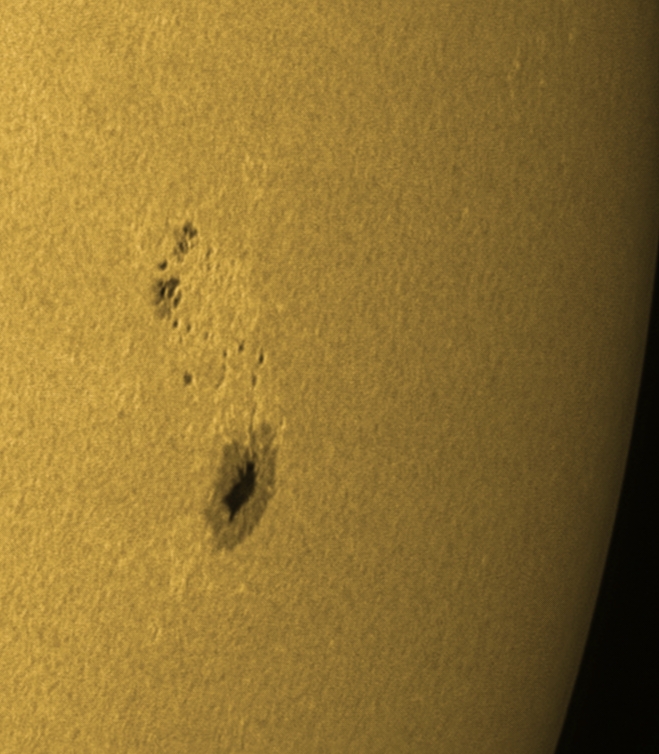Faculae on:
[Wikipedia]
[Google]
[Amazon]
 A facula (plural: faculae ), Latin for "little torch", is literally a "bright spot". The term has several common technical uses. It is used in
A facula (plural: faculae ), Latin for "little torch", is literally a "bright spot". The term has several common technical uses. It is used in
 Solar faculae are bright spots in the
Solar faculae are bright spots in the
/ref> on
 A facula (plural: faculae ), Latin for "little torch", is literally a "bright spot". The term has several common technical uses. It is used in
A facula (plural: faculae ), Latin for "little torch", is literally a "bright spot". The term has several common technical uses. It is used in planetary nomenclature
Planetary nomenclature, like terrestrial nomenclature, is a system of uniquely identifying features on the surface of a planet or natural satellite so that the features can be easily located, described, and discussed. Since the invention of the tel ...
for naming certain surface features of planets and moons,. and is also a type of surface phenomenon on the Sun
The Sun is the star at the center of the Solar System. It is a nearly perfect ball of hot plasma, heated to incandescence by nuclear fusion reactions in its core. The Sun radiates this energy mainly as light, ultraviolet, and infrared radi ...
's photosphere
The photosphere is a star's outer shell from which light is radiated.
The term itself is derived from Ancient Greek roots, φῶς, φωτός/''phos, photos'' meaning "light" and σφαῖρα/''sphaira'' meaning "sphere", in reference to it ...
. In addition, a bright region in the projected field of a light source is sometimes referred to as a facula, and photographers often use the term to describe bright, typically circular features in photographs that correspond to light sources or bright reflections in a defocused image.
Solar facula
 Solar faculae are bright spots in the
Solar faculae are bright spots in the photosphere
The photosphere is a star's outer shell from which light is radiated.
The term itself is derived from Ancient Greek roots, φῶς, φωτός/''phos, photos'' meaning "light" and σφαῖρα/''sphaira'' meaning "sphere", in reference to it ...
that form in the canyons between solar granules, short-lived convection cells several thousand kilometers across that constantly form and dissipate over timescales of several minutes. Faculae are produced by concentrations of magnetic field line
A magnetic field is a vector field that describes the magnetic influence on moving electric charges, electric currents, and magnetic materials. A moving charge in a magnetic field experiences a force perpendicular to its own velocity and to ...
s. Strong concentrations of faculae appear in solar activity
Solar phenomena are natural phenomena which occur within the atmosphere of the Sun. These phenomena take many forms, including solar wind, radio wave flux, solar flares, coronal mass ejections, coronal heating and sunspots.
These phenomena are ...
, with or without sunspots
Sunspots are phenomena on the Sun's photosphere that appear as temporary spots that are darker than the surrounding areas. They are regions of reduced surface temperature caused by concentrations of magnetic flux that inhibit convection. ...
. The faculae and the sunspots contribute noticeably to variations in the "Solar constant
The solar constant (''GSC'') is a flux density measuring mean solar electromagnetic radiation (total solar irradiance) per unit area. It is measured on a surface perpendicular to the rays, one astronomical unit (au) from the Sun (roughly the ...
".
The chromospheric
A chromosphere ("sphere of color") is the second layer of a star's atmosphere, located above the photosphere and below the solar transition region and corona. The term usually refers to the Sun's chromosphere, but not exclusively.
In the S ...
counterpart of a facular region is called a plage
Plage may refer to:
*Plage (astronomy), a bright region in the chromosphere of the Sun
*Plage (mycology), a clear, unornamented area on the basal area of an ornamented fungal spore
* "Plage" (song), a 2011 song by English electronic band Crystal F ...
.
Cererian facula
Cererian faculae were initially speculated to suggest current or past outgassingLPSC 2015: First results from Dawn at Ceres: provisional place names and possible plumes/ref> on
Ceres
Ceres most commonly refers to:
* Ceres (dwarf planet), the largest asteroid
* Ceres (mythology), the Roman goddess of agriculture
Ceres may also refer to:
Places
Brazil
* Ceres, Goiás, Brazil
* Ceres Microregion, in north-central Goiás ...
, perhaps due to volcanism or cometary activity. The brightest cluster of spots (Cereale Facula) is located in the center of an crater called Occator. These bright features have an albedo
Albedo (; ) is the measure of the diffuse reflection of sunlight, solar radiation out of the total solar radiation and measured on a scale from 0, corresponding to a black body that absorbs all incident radiation, to 1, corresponding to a body ...
of about 40%, four times brighter than the average of Ceres's surface. The spots appear to be mostly sodium carbonate
Sodium carbonate, , (also known as washing soda, soda ash and soda crystals) is the inorganic compound with the formula Na2CO3 and its various hydrates. All forms are white, odourless, water-soluble salts that yield moderately alkaline solutions ...
(), implying that hydrothermal activity followed by evaporation of the water is probably what created the spots.
References
{{The Sun Stellar phenomena Solar phenomena Planetary geology